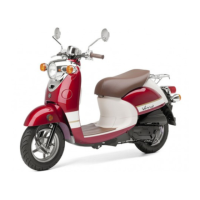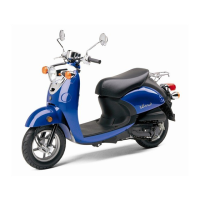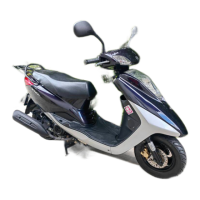Do you have a question about the Yamaha VINO YJ50RT and is the answer not in the manual?
Explains warning symbols and notations used in the manual for clarity and safety.
Emphasizes visibility, operator qualifications, and knowing personal riding limits.
Highlights common errors like excessive speed and improper lean angle in accidents.
Advises wearing protective clothing for legs, ankles, and feet for injury prevention.
Discusses how accessories affect stability and weight distribution, requiring caution.
Explains how handlebar/front fork accessories can affect stability and handling.
Covers safety precautions related to gasoline and exhaust fumes during operation.
Details fire hazards associated with gasoline and refueling, emphasizing caution.
Offers tips on signaling during turns and braking effectively on wet surfaces.
Emphasizes the importance of clear signaling when making turns for safety.
Warns about reduced braking effectiveness on wet roads and advises slow braking.
Provides recommended cold tire pressure for front and rear tires for optimal performance.
Identifies key components of the scooter with numbered labels for easy reference.
Explains how to lock, unlock, and use the ignition key for security and operation.
Advises against turning the key to OFF or LOCK while the vehicle is moving.
Describes the functions of various indicator and warning lights on the dashboard.
Explains the function and conditions for the 2-stroke engine oil level warning light.
Details the operation of the turn signal indicator lights for rider awareness.
Describes the high beam indicator light, which signals when the high beam is on.
Explains how to read the fuel gauge and when to refuel for continuous operation.
Describes the dimmer, turn signal, and horn switches on the left handlebar.
Details how to apply the front brake using the lever located on the right handlebar.
Describes the engine stop switch and its emergency use for immediate shutdown.
Explains how to use the starter switch to crank the engine for starting.
Guides on how to remove and install the fuel tank cap securely.
Advises on the type of fuel and octane rating to use for the engine.
Differentiates between ethanol and methanol gasohol, and their suitability.
Details checking and filling the 2-stroke engine oil for proper lubrication.
Explains the location and use of the helmet holder under the seat.
Provides instructions on how to attach a helmet to the holder.
Warns against riding with a helmet attached to the holder due to control issues.
Covers precautions and tips for using the under-seat storage compartment.
Advises on storing items susceptible to heat and protecting items from moisture.
Gives specific guidance on how to store helmets in the compartment.
Details the load limit for the rear carrier and safe usage.
Stresses the necessity of regular visual inspection for component condition before use.
Advises having the vehicle inspected and repaired if any part is not working properly.
Explains how to use the start switch to ignite the engine.
Describes the use of the kickstarter lever for starting the engine.
Notes the 2-stroke engine oil warning light behavior during engine start.
Explains how to apply the brakes and use turn signals when starting off.
Alerts users that the engine and exhaust system can become very hot.
Explains the importance of spark plug checks and how to inspect it.
Step-by-step guide on how to remove the spark plug cap and plug.
Details spark plug installation, tightening torque, and gap adjustment.
Lists the recommended spark plug type and gap.
Explains how to check and fill the final transmission oil.
Provides recommended oil type and quantity for the transmission.
Warns about checking for oil leakage and its potential causes.
Guides on cleaning the air filter sponge material with solvent.
Details the process of cleaning the air filter sponge with solvent.
Advises against using gasoline or flammable solvents for cleaning.
States that carburetor adjustments require professional knowledge and dealer service.
Emphasizes checking and adjusting tire pressure for performance and safety.
Warns that loading significantly impacts handling, braking, and safety.
Covers tire inspection, minimum tread depth, and tire information.
Specifies the minimum required tread depth for tires.
Warns about riding with worn tires and the need for immediate replacement.
Explains how to check and adjust the free play in the front and rear brake levers.
Lists the acceptable free play range for front and rear brake levers.
Advises consulting a dealer if proper brake lever adjustment cannot be obtained.
Details checking the throttle grip and lubricating the cable.
Explains that the battery is sealed and requires no maintenance, with electrolyte warnings.
Warns about the hazardous nature of battery electrolyte and provides first aid.
Provides guidance on storing the battery and charging requirements.
Offers instructions for storing the battery long-term and checking charge.
Advises using a special constant-voltage charger for sealed batteries.
Introduces troubleshooting for common operational issues like starting or power loss.
Stresses using genuine Yamaha replacement parts for reliability and longevity.
Presents a step-by-step troubleshooting guide for starting issues.
Advises on cleaning methods, avoiding harsh chemicals, and protecting parts.
Provides specific cleaning advice for windshields and plastic parts.
Warns against getting oil or wax on brakes or tires during cleaning.
Details steps for preparing the scooter for long-term storage to prevent corrosion.
Advises storing the scooter in a cool, dry, and well-ventilated area.
Provides methods to prevent corrosion, especially in specific environments.
Recommends specific temperature ranges for storing the scooter.
Lists recommended engine oil and transmission oil types and quantities.
Details recommended fuel type, tank capacity, and carburetor model.
Provides details for the spark plug, including type and gap.
Lists specifications for the clutch and transmission systems.
Details chassis type, caster angle, and trail measurements.
Lists the size, manufacturer, and model of the front tire.
Details front and rear brake system types and operation.
Lists front and rear suspension types and travel dimensions.
Provides details on voltage, capacity, bulb wattages, and fuse rating.
Explains how to record and use the key identification number for replacement.
Locates the VIN stamped on the frame and its purpose for registration.
Guides on reporting potential safety defects to NHTSA and Yamaha.
Outlines prohibited acts related to tampering with emission control systems.
Lists specific modifications or removals of emission control devices that are prohibited.
Outlines the terms and conditions of the limited warranty for the vehicle.
Explains the procedure for obtaining warranty service from an authorized dealer.
Details the process for transferring the warranty to a new owner.
Outlines the warranty coverage for emissions control systems.
Instructs owners to notify Yamaha of address changes for recall purposes.
Describes the benefits and coverage of the Yamaha Extended Service plan.
Highlights features like TRIP coverage, nationwide honor, and transferability.
Explains that the Y.E.S. plan is available to owners within the Limited Warranty period.
| Displacement | 49 cc |
|---|---|
| Fuel System | Carburetor |
| Ignition | CDI |
| Starter | Electric and kick |
| Final Drive | V-Belt |
| Front Suspension | Telescopic fork |
| Rear Suspension | Unit Swing |
| Front Brake | Drum |
| Rear Brake | Drum |
| Front Tire | 90/90-10 |
| Rear Tire | 90/90-10 |
| Seat Height | 720 mm |
| Width | 650 mm |
| Transmission | Automatic |
| Fuel Capacity | 4.5 liters |











